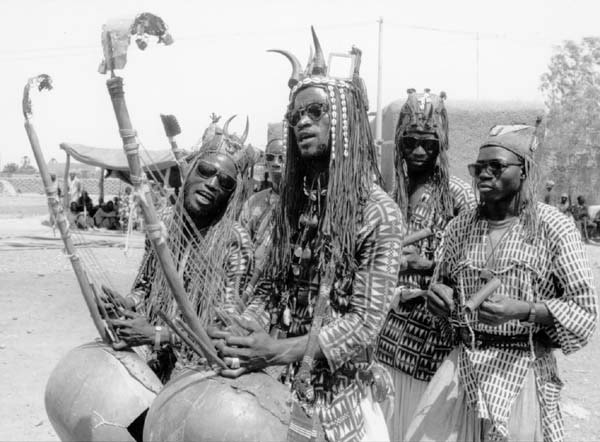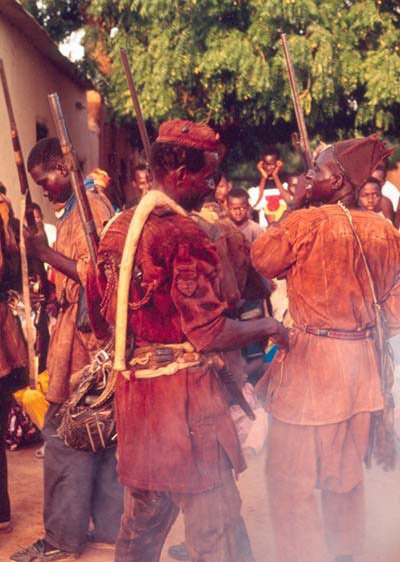Music for the hunters
by Elisabeth den Otter
The Bamanan are famous for their hunting skills. Once a year the hunters gather for a feast, during which they dance around in a circle, shooting their rifles at intervals, with the musicians playing amidst them. Two to three men play the 'donso ngoni' (hunter's harp), and two men the 'ngèny-èmè' (iron grater). Sometimes the hunters ululate and the sound of the small hunter's flute can be heard. The harp player also beats upon the calabash with his ring, as a rhyth-mic accompaniment. One of the hunters enters into a dialogue with the musicians, calling them 'masters' ('karamogow'). They sing the praises of a certain Daouda, renowned for his strength and lack of fear. No one can beat him, he is the strongest. The musicians menti-on the names of the animals he has killed. The dialogue is a playful way of criticising.
Daouda ye kamalen ye
Donzo kamalen ye
O bè kèra doma kamalen ye
Sogo fa kamalen(Daouda is a strong young man
A strong young hunter
He has become a strong young sorcerer
A strong young man who kills animals)This is followed by an exchange between a 'griot' -who has to be prompted by someone from the village- and the musi-cians, which centres around the idea that great hunters have magic powers and that Daouda can make a live animal appear among them. The musicians want to eat grilled hyena meat and dare Daouda to use his powers: "N'ko, galon bè i da" (I say, the insult is in your mouth), meaning: you are lying. They continue with "N'ko, jeli faama, i tè Daouda bò. Ni fen t'a kònò, a ko fò an ye (I say, king of the griots, you do not equal Daouda. If he has nothing in his stomach, let him tell us). Reference is made to master-hunters, and the fact that few hunters remain which can compare to them.
Mud cloth
Mali is famous for its traditional 'bogolan'`, or mud-cloth. It is used by women as wrappers and by men as shirts and pants. They are usually made to order. Hand woven cotton strips are sewn together and dyed with natural dyes made from roots, leaves and bark of the n'galama tree (the yellow-brown base) and a mix of ferruginous mud, blood, or millet (the design). The result is a black cloth with yellowish designs, which may be bleached out afterwards. In this 'negative' technique the designs are formed by the untouched areas of cotton that remain after the mud dye is painted onto the cloth. The small, symbol-like marks act as building blocks for complex patterns, and are repeated over a large surface. Most of the designs are abstract or semi abstract representations of commonly known objects (drums, cushions), animals (grasshoppers) and of the human form.
The Bamanan hunters, who are famed for their hunting skills and feared for their magic powers, wear reddish-brown outfits that are dyed by the bogolan method. Sometimes black mud-decorations are added. The second male age group of the youth association wears hunter outfits during the masquerade, as does the masked N'Domo dancer.
Lately, bogolan has become quite popular. It has become a medium for contemporary artists who sell their work in art galleries, and designers' clothes in Africa and Europe are made from it. Tourists buy bogolans with figurative designs: village scenes, Dogon dancers, and other 'traditional' motifs. A poor man's version of bogolan printed cotton is produced by the national Comatex textile factory.

